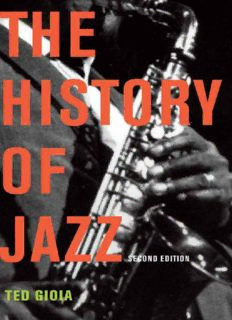
The history of jazz PDF
Preview The history of jazz
The History of Jazz THE HISTORY OF JAZZ SECOND EDITION Ted Gioia OXFORD UNIVERSITY PRESS Oxford University Press, Inc., publishes works that further Oxford University’s objective of excellence in research, scholarship, and education. Oxford New York Auckland Cape Town Dar es Salaam Hong Kong Karachi Kuala Lumpur Madrid Melbourne Mexico City Nairobi New Delhi Shanghai Taipei Toronto With offices in Argentina Austria Brazil Chile Czech Republic France Greece Guatemala Hungary Italy Japan Poland Portugal Singapore South Korea Switzerland Thailand Turkey Ukraine Vietnam Copyright © 2011 by Ted Gioia Published by Oxford University Press, Inc. 198 Madison Avenue, New York, New York 10016 www.oup.com Oxford is a registered trademark of Oxford University Press. All rights reserved. No part of this publication may be reproduced, stored in a retrieval system, or transmitted, in any form or by any means, electronic, mechanical, photocopying, recording, or otherwise, without the prior permission of Oxford University Press. Library of Congress Cataloging-in-Publication Data Gioia, Ted. The history of jazz / Ted Gioia. — 2nd ed. p. cm. Includes bibliographical references and index. ISBN 978-0-19-539970-7 1. Jazz—History and criticism. I. Title. ML3506.G54 2011 781.6509—dc22 2010023182 All photographs in this book are courtesy of The Frank Driggs Collection. 9 8 7 6 5 4 3 2 1 Printed in the United States of America on acid-free paper for my wife, Tara Contents 1. The Prehistory of Jazz 2. New Orleans Jazz 3. The Jazz Age 4. Harlem 5. The Swing Era 6. Modern Jazz 7. The Fragmentation of Jazz Styles 8. Freedom and Fusion 9. Traditionalists and Postmodernists 10. Jazz in the New Millennium Notes Further Reading Recommended Listening Acknowledgments Index The History of Jazz 1 The Prehistory of Jazz THE AFRICANIZATION OF AMERICAN MUSIC An elderly black man sits astride a large cylindrical drum. Using his fingers and the edge of his hand, he jabs repeatedly at the drumhead—which is around a foot in diameter and probably made from an animal skin—evoking a throbbing pulsation with rapid, sharp strokes. A second drummer, holding his instrument between his knees, joins in, playing with the same staccato attack. A third black man, seated on the ground, plucks at a stringed instrument, the body of which is roughly fashioned from a calabash. Another calabash has been made into a drum, and a woman beats at it with two short sticks. One voice, then other voices join in. A dance of seeming contradictions accompanies this musical give-and- take, a moving hieroglyph that appears, on the one hand, informal and spontaneous yet, on closer inspection, ritualized and precise. It is a dance of massive proportions. A dense crowd of dark bodies forms into circular groups— perhaps five or six hundred individuals moving in time to the pulsations of the music, some swaying gently, others aggressively stomping their feet. A number of women in the group begin chanting. The scene could be Africa. In fact, it is nineteenth-century New Orleans. Scattered firsthand accounts provide us with tantalizing details of the slave dances that took place in the open area then known as Congo Square—today Louis Armstrong Park stands on roughly the same ground—and there are perhaps no more intriguing documents in the history of African American music. Benjamin Latrobe, the noted architect, witnessed one of these collective dances on February 21, 1819, and not only left us a vivid written account of the event but made several sketches of the instruments used. These drawings confirm that the musicians of Congo Square, circa 1819, were playing percussion and stringed instruments virtually identical to those characteristic of indigenous African music. Later documents add to our knowledge of the public slave dances in New Orleans but still leave us with many open questions—some of which, in time,
Description: